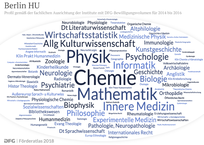Research
(i)Development of time-dependent local Coupled Cluster (response) methods for exited state properties of extended molecular systems ⇒ MOLPRO project.
In the last decade new local ab initio methods with low or even linear scaling of the computational cost with molecular size have been developed. These allowed for the treatment of electron correlation at high levels of theory, e.g., Coupled Cluster theory, also for extended molecular systems. Yet, so far, these methods were restricted to electronic closed-shell ground states. In the context of the present project efficient local methods for calculating molecular properties of electronically excited states are devised. Basis is the time-dependent Coupled Cluster Response theory. Local Coupled Cluster response theory is applicable for systems far beyond hundred atoms, hence entering an application area accessible so far only for time-dependent Density Functional theory (which is problematic in many respects). Analytic energy gradients (w.r. to nuclear displacements) are presently implemented, which are needed to locate stationary points on excited energy hypersurfaces at this level of theory.
(ii) Development of local ab initio electronic structure methods for periodic systems such as surfaces, physisorption on surfaces, and non-conducting crystals ⇒ CRYSCOR project.
This area is the traditional domain of Density Functional theory (DFT). However, DFT has in practice many shortcomings. For example, long-range van der Waals forces cannot be described, which in many cases play an important or even dominant role in weakly bound crystals or physisorption of molecules on surfaces. In collaboration with the group of Prof. Pisani in Torino an efficient local MP2 (Møller-Plesset perturbation theory of second order) program for periodic systems has been developed, which exploits extensively both translational and point-group symmetry. Density Fitting is utilized for an efficient evaluation of the required electron repulsion integrals. Gaussian and Poisson basis functions are employed for the Density Fitting in direct and reciprocal space, respectively. Lattice summations are primarily carried out in reciprocal space. This method takes into account electron correlation effects as intermolecular van der Waals forces in periodic systems. Target systems of this method are, as already mentioned, physisorption on non-conducting surfaces, as well as crystals with cohesion energies dominated by weak van der Waals forces. Presently, the methodology is further developed towards local excited states in periodic systems (Frenkel excitons).
(iii) Quantum Mechanical/Molecular Mechanical studies of light induced processes in blue-light photoreceptors.
In the context of the Graduate College GRK 640 the photocycle of BLUF (Blue Light using Flavin-adenine-dinucleotide FAD) domains of sensory photoreceptor proteins is studied in our group. Density Functional theory, (local) MP2 and Coupled Cluster methods, i.e., the related response methods for the electronically excited states, are coupled via QM/MM to classical empirical force fields. Local methods allow here the use of substantially larger QM regions than conventional ab initio methods. Based on such calculations we recently proposed a conclusive reaction mechanism for the formation of the light-adapted signaling state, which is in line with the presently avaliable experimental data for various BLUF domains.

